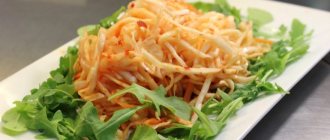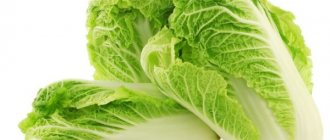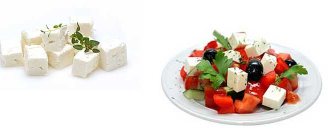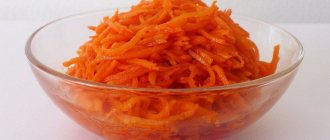Proper nutrition is the key to a healthy human body. To maintain health, we need to regularly receive as many vitamins and nutrients as possible, which we can purchase in various foods, such as vegetables, fruits, meat, etc.
Cabbage is an exceptional product that contains a huge amount of various vitamins and minerals that are vital for humans, and at the same time, it is a low-calorie product.
Available vitamins in fresh cabbage:
vitamin A (necessary for vision and bones), B vitamins, namely B1 (normalizes the cardiovascular system), B2 (famous for its regenerative properties), B5 (promotes the production of cellular energy), B3 (important for the normal functioning of organs), and also phosphorus, potassium, calcium, zinc, magnesium, manganese, iodine, iron, sulfur, fiber, fats, folic and pantothenic acid, fructose and vitamin K (normalizes metabolism in connective tissues). The main feature is that it contains a record amount of vitamin C, as well as the presence of vitamin U, which promotes the healing of stomach ulcers. This vitamin has a very positive effect on the entire digestive system of the body.
Types of cabbage and its calorie content
Interesting! There are a huge number of varieties of this plant - more than fifty species. The most popular were: white cabbage, cauliflower, sea cabbage, red cabbage, Beijing cabbage, Brussels sprouts, Chinese cabbage and broccoli.
.
Since this vegetable is very healthy, and its calorie content is very low (28 kcal per 100 grams of product), cabbage becomes one of the main ingredients in the diet of people who adhere to a diet for various reasons, such as the desire to get rid of excess weight, cleanse body, etc. Calorie content
ready-made
vitamin cabbage salad
is not much higher. It all depends on the additional ingredients.
Sea kale has become the most popular in dietetics, since its calorie content is only 6 kcal. After it, Chinese cabbage, which contains 12 kcal, is also popular. White cabbage, unlike other varieties of this vegetable, is more high in calories. But it is the richest in vitamin C and B vitamins. And this fermented vegetable contains 19 kcal, but when it is digested, it takes more energy than it can bring into the body. Therefore, it is also called a “negative calorie” product.
Salads with white cabbage, depending on additional ingredients, also have different calorie content. For example, if you dilute it with carrots, then the nutritional value of such a dish will be 50.2 kcal, and if we add vegetable oil, we will get 67.9 kcal per 100 grams of product. This is how we found out what the calorie content of vitamin salad will be per 100 grams
.
Recipe: Vitamin salad from cabbage and carrots. Calorie, chemical composition and nutritional value.
Nutritional value and chemical composition of “Vitamin salad from cabbage and carrots.”
The table shows the nutritional content (calories, proteins, fats, carbohydrates, vitamins and minerals) per 100 grams of edible portion.
| Nutrient | Quantity | Norm** | % of the norm in 100 g | % of the norm in 100 kcal | 100% normal |
| Calorie content | 89.5 kcal | 1684 kcal | 5.3% | 5.9% | 1882 |
| Squirrels | 1.4 g | 76 g | 1.8% | 2% | 5429 g |
| Fats | 5.2 g | 56 g | 9.3% | 10.4% | 1077 g |
| Carbohydrates | 8.6 g | 219 g | 3.9% | 4.4% | 2547 g |
| Organic acids | 0.7 g | ~ | |||
| Alimentary fiber | 1.8 g | 20 g | 9% | 10.1% | 1111 g |
| Water | 80.5 g | 2273 g | 3.5% | 3.9% | 2824 g |
| Ash | 1.696 g | ~ | |||
| Vitamins | |||||
| Vitamin A, RE | 491.6 mcg | 900 mcg | 54.6% | 61% | 183 g |
| beta carotene | 2.976 mg | 5 mg | 59.5% | 66.5% | 168 g |
| Vitamin B1, thiamine | 0.033 mg | 1.5 mg | 2.2% | 2.5% | 4545 g |
| Vitamin B2, riboflavin | 0.06 mg | 1.8 mg | 3.3% | 3.7% | 3000 g |
| Vitamin B4, choline | 8.72 mg | 500 mg | 1.7% | 1.9% | 5734 g |
| Vitamin B5, pantothenic | 0.064 mg | 5 mg | 1.3% | 1.5% | 7813 g |
| Vitamin B6, pyridoxine | 0.093 mg | 2 mg | 4.7% | 5.3% | 2151 g |
| Vitamin B9, folates | 15.673 mcg | 400 mcg | 3.9% | 4.4% | 2552 g |
| Vitamin C, ascorbic acid | 37.96 mg | 90 mg | 42.2% | 47.2% | 237 g |
| Vitamin E, alpha tocopherol, TE | 2.404 mg | 15 mg | 16% | 17.9% | 624 g |
| Vitamin H, biotin | 0.147 mcg | 50 mcg | 0.3% | 0.3% | 34014 g |
| Vitamin K, phylloquinone | 50 mcg | 120 mcg | 41.7% | 46.6% | 240 g |
| Vitamin RR, NE | 0.8204 mg | 20 mg | 4.1% | 4.6% | 2438 g |
| Niacin | 0.673 mg | ~ | |||
| Macronutrients | |||||
| Potassium, K | 232.87 mg | 2500 mg | 9.3% | 10.4% | 1074 g |
| Calcium, Ca | 39.88 mg | 1000 mg | 4% | 4.5% | 2508 g |
| Silicon, Si | 38.571 mg | 30 mg | 128.6% | 143.7% | 78 g |
| Magnesium, Mg | 19.33 mg | 400 mg | 4.8% | 5.4% | 2069 g |
| Sodium, Na | 408.14 mg | 1300 mg | 31.4% | 35.1% | 319 g |
| Sera, S | 25.96 mg | 1000 mg | 2.6% | 2.9% | 3852 g |
| Phosphorus, P | 33.3 mg | 800 mg | 4.2% | 4.7% | 2402 g |
| Chlorine, Cl | 647.16 mg | 2300 mg | 28.1% | 31.4% | 355 g |
| Microelements | |||||
| Aluminium, Al | 428.1 mcg | ~ | |||
| Bor, B | 171.4 mcg | ~ | |||
| Vanadium, V | 24.24 mcg | ~ | |||
| Iron, Fe | 0.581 mg | 18 mg | 3.2% | 3.6% | 3098 g |
| Yod, I | 3.06 mcg | 150 mcg | 2% | 2.2% | 4902 g |
| Cobalt, Co | 2.48 mcg | 10 mcg | 24.8% | 27.7% | 403 g |
| Lithium, Li | 1.469 mcg | ~ | |||
| Manganese, Mn | 0.1556 mg | 2 mg | 7.8% | 8.7% | 1285 g |
| Copper, Cu | 68.28 mcg | 1000 mcg | 6.8% | 7.6% | 1465 g |
| Molybdenum, Mo | 12.143 mcg | 70 mcg | 17.3% | 19.3% | 576 g |
| Nickel, Ni | 10.653 mcg | ~ | |||
| Rubidium, Rb | 5.8 mcg | ~ | |||
| Selenium, Se | 0.209 mcg | 55 mcg | 0.4% | 0.4% | 26316 g |
| Strontium, Sr | 2.13 mcg | ~ | |||
| Fluorine, F | 19.61 mcg | 4000 mcg | 0.5% | 0.6% | 20398 g |
| Chromium, Cr | 3.8 mcg | 50 mcg | 7.6% | 8.5% | 1316 g |
| Zinc, Zn | 0.349 mg | 12 mg | 2.9% | 3.2% | 3438 g |
| Digestible carbohydrates | |||||
| Starch and dextrins | 0.11 g | ~ | |||
| Mono- and disaccharides (sugars) | 8.5 g | max 100 g | |||
| Glucose (dextrose) | 2.204 g | ~ | |||
| Sucrose | 1.102 g | ~ | |||
| Fructose | 1.224 g | ~ | |||
| Essential amino acids | 0.3 g | ~ | |||
| Arginine* | 0.062 g | ~ | |||
| Valin | 0.046 g | ~ | |||
| Histidine* | 0.021 g | ~ | |||
| Isoleucine | 0.039 g | ~ | |||
| Leucine | 0.05 g | ~ | |||
| Lysine | 0.047 g | ~ | |||
| Methionine | 0.016 g | ~ | |||
| Methionine + Cysteine | 0.029 g | ~ | |||
| Threonine | 0.035 g | ~ | |||
| Tryptophan | 0.008 g | ~ | |||
| Phenylalanine | 0.042 g | ~ | |||
| Phenylalanine+Tyrosine | 0.08 g | ~ | |||
| Nonessential amino acids | 0.676 g | ~ | |||
| Alanin | 0.055 g | ~ | |||
| Aspartic acid | 0.138 g | ~ | |||
| Glycine | 0.036 g | ~ | |||
| Glutamic acid | 0.226 g | ~ | |||
| Proline | 0.043 g | ~ | |||
| Serin | 0.044 g | ~ | |||
| Tyrosine | 0.035 g | ~ | |||
| Cysteine | 0.015 g | ~ | |||
| Sterols (sterols) | |||||
| beta sitosterol | 11.429 mg | ~ | |||
| Saturated fatty acids | |||||
| Saturated fatty acids | 0.6 g | max 18.7 g | |||
| 16:0 Palmitinaya | 0.316 g | ~ | |||
| 18:0 Stearic | 0.209 g | ~ | |||
| 20:0 Arakhinovaya | 0.015 g | ~ | |||
| 22:0 Begenovaya | 0.036 g | ~ | |||
| Monounsaturated fatty acids | 1.214 g | min 16.8 g | 7.2% | 8% | |
| 18:1 Oleic (omega-9) | 1.209 g | ~ | |||
| Polyunsaturated fatty acids | 3.316 g | from 11.2 to 20.6 g | 29.6% | 33.1% | |
| 18:2 Linolevaya | 3.051 g | ~ | |||
| Omega-3 fatty acids | 0.1 g | from 0.9 to 3.7 g | 11.1% | 12.4% | |
| Omega-6 fatty acids | 3.1 g | from 4.7 to 16.8 g | 66% | 73.7% |
The energy value of the vitamin salad from cabbage and carrots is 89.5 kcal.
- Serving = 82 g (73.4 kcal)
Primary Source: Created in the application by the user. Read more.
** This table shows the average levels of vitamins and minerals for an adult. If you want to know the norms taking into account your gender, age and other factors, then use the “My Healthy Diet” application.
Main properties and benefits
Let's look at the main points:
- after slight temperature treatment of cabbage, the content of ascorbic acid in it increases, which occurs due to ascorbigen, which is converted into vitamin C;
- helps improve metabolism;
- tartronic acid, which is part of this product, has anti-sclerosis properties, and also prevents the deposition of fats and cholesterol (to preserve tartronic acid in the vegetable, it should not be subjected to heat treatment);
- due to the high choline content, it normalizes the body's metabolic fat processes;
- the phytoncides that are present in its composition have a detrimental effect on many harmful microbes, including tuberculosis bacilli;
- fiber normalizes the functioning of the intestines and promotes the elimination of toxins.
People came up with various salads with this product to maintain the effectiveness and variety of their diet. And now we will look at a few of them.
Useful properties of fresh cabbage
The maximum amount of useful substances is contained in fresh, well-ripened cabbage. The average fat content in this vegetable is from 0.16 to 0.67%, carbohydrates - from 5.25 to 8.56%, protein compounds - from 1.27 to 3.78%. Cabbage also contains mineral salts of manganese, iron, sulfur, zinc, phosphorus, calcium and potassium, other trace elements, phytoncides, enzymes, organic acids, including tartronic acid.
Cabbage contains easily soluble sugars - glucose, sucrose and fructose.
Cabbage is especially rich in vitamin C, beta-carotene, B vitamins, but in addition, it also contains rare vitamin U, which has a therapeutic effect on stomach and intestinal ulcers, gastritis, ulcerative colitis, stimulating peristalsis and activating intestinal function. The large amount of fiber contained in cabbage leaves also helps speed up metabolism.
Cabbage is a low-calorie vegetable, 100 g contains only 24 to 30 kcal, its energy value is directly dependent on how many and what mineral salts it contains, and this, in turn, depends on the composition of the soil and the fertilizers used. The average value is usually taken to be 27 kcal. Cabbage helps remove cholesterol, and under the influence of tartronic acid, carbohydrates are not processed into fat cells, but are absorbed in the body. Due to its low calorie content and health benefits, fresh cabbage is included in many effective diets.
To reduce the calorie content of fresh cabbage salad, instead of vegetable oil, you can use a mixture of olive oil, lemon juice and a small amount of honey.
Salad of fresh white cabbage and carrots
A very light salad recommended for athletes. Very nutritious and suitable for absolutely any side dish on your table. We add a few cloves of garlic to this recipe, and don’t forget about the onions. You can really see the difference between a standard salad and this one, which has its own little twist.
Ingredients:
- white cabbage – 400 g;
- onion or salad - 1 onion;
- carrots – 1 pc.;
- vinegar – 1 tsp;
- garlic – 3 cloves;
- vegetable oil – 3-4 tbsp. l.;
- sugar – 2 tsp;
- salt - to taste.
Preparation:
Let's start. Shred the cabbage and wash it before doing this. Peel the carrots and grate them on a grater, preferably a coarse one. The garlic should be peeled and squeezed through a press, otherwise finely chopped. Peel the onion and cut it into cubes.
Place these ingredients in one pan or bowl. Season our salad with vinegar
We wash the cabbage and then chop it. Grate the peeled carrots on a coarse grate. Squeeze the peeled garlic through a press; otherwise, the garlic needs to be finely chopped. After peeling the onion, it is best to cut it into cubes. Place all the ingredients in one bowl.
Let's season our salad with sunflower oil and vinegar, sugar and salt. Mix everything thoroughly and you're done.
Bon appetit!
Beetroot and cabbage salad with carrots
Beets are a healthy product that should be consumed every day, both boiled and raw.
The following ingredients are required:
- cabbage – 800 gr;
- small carrots – 1-2 pcs;
- sugar beet – 2 pcs;
- cucumber – 1 piece;
- vinegar (apple vinegar will do) – 3 tbsp. l;
- onion – 1 piece;
- sunflower oil – 2 tbsp. l;
- salt to taste.
Cooking time: 40 min.
The number of calories per 100 g is 110 kcal.
Cooking instructions:
- Wash all vegetables except beets, peel and cut into strips. Stir and add chopped onion;
- Next, add vinegar and spices to the slices. Set the salad aside for 20 minutes;
- The beets need to be boiled for some time, approximately 20 minutes. Then peel and cut into small strips. Add sunflower oil to it;
- After the cabbage slices have steeped, add the beets with sunflower oil. Mix everything and garnish with fresh herbs before serving.
Cabbage salad with carrots, vinegar and mayonnaise
A cold vegetable dish goes well with mayonnaise, but then it cannot be considered dietary. Mayonnaise is a rather high-calorie product, but any culinary preparations with it are very tasty and satisfying.
The following ingredients are required:
- cabbage – 800 gr;
- small carrots – 1-2 pcs;
- onion – 1 piece;
- fresh cucumber – 2 pcs;
- vinegar – 3 tsp;
- mayonnaise - as much as the salad requires;
- salt and ground black pepper - as much as the salad requires;
- sugar – 1-2 tsp.
Cooking time: 40 min.
Calorie content per 100 grams is about 200 kcal.
Cooking instructions:
- Wash and peel all vegetables. Peel the cucumber if it is hard;
- Cut cabbage, carrots, cucumber into small strips. Mix everything in a deep bowl;
- Finely chop the onion into cubes or strips. Add to previous ingredients;
- Season the resulting mixture with vinegar and spices, add sugar and mix thoroughly;
- Vegetables need to sit for a few minutes to release the juice, up to 20 minutes. Then season with mayonnaise before serving.
Contraindications to eating cabbage salads
As we have already said, cabbage is indicated for most people and helps get rid of many diseases, but some people should stop eating cabbage. Despite the low calorie content of cabbage salad, it should not be consumed after abdominal surgery. Those who have undergone chest surgery should also give up cabbage.
It is not recommended to consume cabbage salad for diseases such as pancreatitis, enterocolitis, as well as exacerbation of stomach and duodenal ulcers. In case of acute diseases of the thyroid gland, you should also stop eating cabbage.
Her Majesty cabbage
Modern national cuisines are simply unthinkable without potatoes and tomatoes. But these two products became known in Europe only after the discovery of America! As well as zucchini (overseas), sunflower and many other vegetables, root vegetables and fruits that are now familiar to us. What did our ancestors eat in the old days? Chronicles report huge areas occupied by cabbage gardens. This vegetable was on the tables of Europeans at any time of the year and in different forms - boiled, stewed, fried, pickled. And of course, fresh. Cabbage was so valued that it was called the “queen of all vegetables.” But salads began to be prepared relatively recently. More precisely, the ancient Romans ate them, but northern Europeans treated them coolly, considering them to be feed for livestock. Cabbage salad, which has very low calorie content, was not considered food. The vegetable was added to soups or fermented for the winter, using the product as a side dish. But times have changed, and since the 18th century, salads have become fashionable in Russia.










